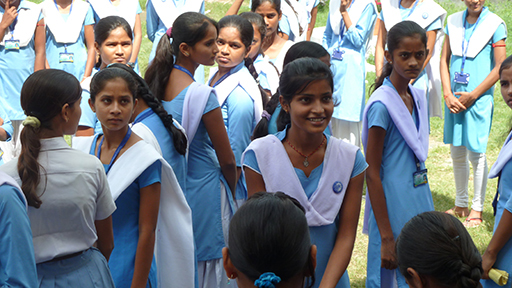3 Discrete and continuous data
Numerical data can be of two types: ‘discrete’ and ‘continuous’. Discrete data is counted, whereas continuous data is measured.
- Discrete data can only take certain values. For example, the number of students in a class is discrete as you cannot have half of a student. Hence bar charts, such as the ‘sisters’ example in Activity 1, show discrete data.
- Continuous data can take any value within a range. For example, a person’s height could be any value within the range of human heights – people do not grow to certain fixed heights. Time is another good example as you can measure the time taken to run, say, from 100 m to fractions of a second. Representing continuous data requires more care because you have to decide which part of the graph each single measurement fits in, and sometimes this is a fine judgement. The next activity asks the students to think about this.
Activity 3: ‘People maths’ and histograms
Preparation
Once again, this activity is best done outside the classroom for reasons of space. You will need a way to measure heights, for example a stick about 2 m long marked in cm.
This activity will provide good opportunities for you to use questioning to promote your students’ thinking. As part of your planning, you can use Resource 2 to help you think about how you will use questioning during the activity.
Use a group of about 20 students so that there are enough to divide up into categories but not so many that what you are illustrating becomes obscured.

The activity
- Ask the students to arrange themselves in order of their height.
- Ask a pair of students to find the median height.
- Ask one student to find the range of this group of students by measuring the height of the shortest and the tallest person. Discuss whether this is the same as the range of the whole class. Why, or why not?
- Ask the students: ‘If someone wanted to know the ‘average’ height of an 11-year-old (or the ‘average’ age of students in your class) would the worked out median be a good representation? Why, or why not?’
- Now ask: ‘I want you to draw a histogram for your heights. Or should this be a bar chart? ‘
- Ask the students what would be a sensible way to divide up the heights of the students to make a chart; this will depend on the range. Aim for five ‘bars’. Move the students to make the bars.
Now move back to the classroom.
- Ask a student to measure and record all the heights of the 20 students on the blackboard.
- Ask the students to construct a tally chart and then to draw the histogram for this data.
- Ask why the bars on the histogram touch whilst the bars on the bar chart did not.
Video: Using questioning to promote thinking |
Case Study 3: Mrs Mohanty reflects on using Activity 3
My class contained 63 students, so I asked 26 of them to come forward, taking care to see a wide range of heights was represented. The rest were asked to stand back and help make the observations and note down the discussions.
The discussion on why they could not be represented as bar graphs was heated and extremely participatory. Mohit said that it would seem we will have to make 26 bars when one of the students said that they could very well be represented as a bar each in a histogram if the measuring was carried out extremely accurately.
Then there was a discussion on how many groups we could make, whether there was a restriction or rule by which we could decide. That was when we talked about how the range could help us decide on this. Some wanted the class interval size to be 3 cm, and some were for having it 5 cm. Ultimately I asked them to do what they felt was right and to actually make the groups and see how they worked when shown on the paper. So we made a line and measured all the 26 students for their heights.
I asked them to form groups of four for putting the data on a proper form by using the tally marks and then drawing the histograms. At this point I also thought it advisable to talk about why bar charts have gaps between the bars and histograms do not. This discussion was also very interesting and quite a few contributed to it. By the end of it I felt that they had convinced each other of the reasons for it being so.
Pause for thought Mrs Mohanty included a lot of whole class discussion during this activity. Can you think of any strategies that she might have used to include discussion in pairs or smaller groups during the main part of the activity? Now think about how the activity went with your class and reflect on the following questions:
|
2 Moving from physical representation to recording data
